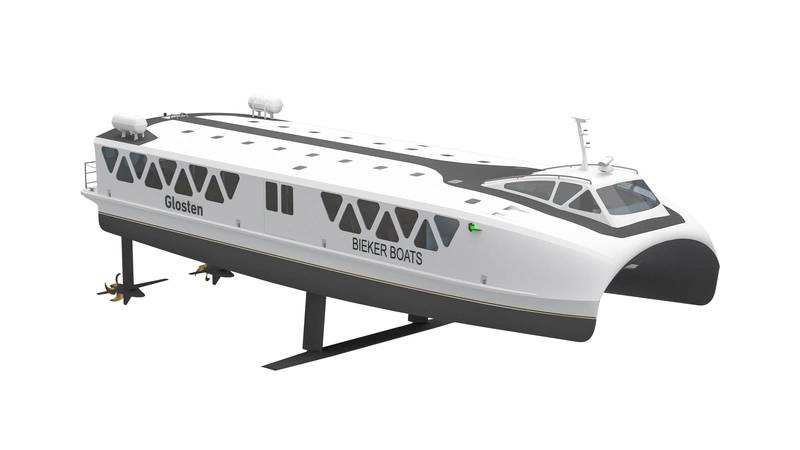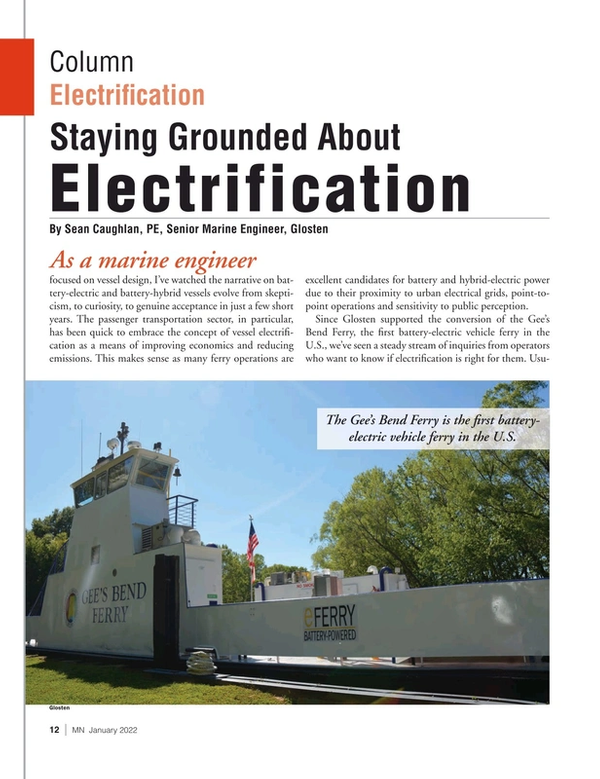
Staying Grounded About Electrification
As a marine engineer focused on vessel design, I’ve watched the narrative on battery-electric and battery-hybrid vessels evolve from skepticism, to curiosity, to genuine acceptance in just a few short years. The passenger transportation sector, in particular, has been quick to embrace the concept of vessel electrification as a means of improving economics and reducing emissions. This makes sense as many ferry operations are excellent candidates for battery and hybrid-electric power due to their proximity to urban electrical grids, point-to-point operations and sensitivity to public perception.
Since Glosten supported the conversion of the Gee’s Bend Ferry, the first battery-electric vehicle ferry in the U.S., we’ve seen a steady stream of inquiries from operators who want to know if electrification is right for them. Usually, the first question we’re asked is whether the requisite batteries will fit on their vessel. This is a great question to start with, but there are many other factors in establishing whether electrification is a feasible option. While improvements in the energy density and cost of lithium-ion batteries in recent years have engendered a lot of excitement, it’s important to have a realistic understanding of what’s needed to integrate batteries into a vessel.
Commercial marine batteries need to cycle continuously day in and day out and still last between five and 10 years, both of which drive the size of the battery systems up. They are also designed and tested according to strict safety standards, critical to their long-term uptake within the industry.
Adhering to the design and installation requirements of the vessel’s flag state, class society or both, may be required and is critical to maintaining and improving the safety of lithium-ion battery installations. These design and regulatory requirements all come with a cost, volume and weight penalty. Installation requirements for a battery room include cooling, ventilation, temperature monitoring, gas monitoring, and limits on the equipment that can share the same compartment. Structural fire protection is required to protect adjacent spaces from a fire, and fire suppression is also needed, similar to a Class A machinery space. So, while energy density and costs are indeed improving over time, this effect is considerably dampened by many other necessary design factors.
Depending on the size of the vessel, accommodating the space and weight for the electrical equipment needed for propulsion and auxiliary power can be a challenge. Displacement monohulls which operate at modest speeds have an easier time accommodating this equipment, which is why monohull ferries are among the early movers in the transition to all-electric. Conventional high-speed catamarans, on the other hand, will find it difficult to maintain reasonable range while fitting batteries, motors, drives, transformers and switchgear on a vessel designed for speed.
Vessel designers must manage the tradeoffs of increasing range, reducing charging time, and meeting basic vessel mission requirements—all while adhering to strict safety regulations. As technology improves over time, equipment will get smaller and lighter, but generally speaking the most straightforward means of reducing battery, motor, and power electronics size is improving vessel efficiency. To reduce the largest consumer of electrical power, typically propulsion, we must reduce the resistance of the vessel through water and waves. Glosten is working with leaders in carbon fiber hydrofoils, Bieker Boats, to overcome this challenge through the development of a carbon fiber hydrofoil ferry. The foil ferry dramatically reduces drag by lifting the hull out of the water on hydrofoils, which are essentially underwater wings. Energy consumption is reduced by 50% or more, allowing for high-speed travel with a fraction of the energy expended by traditional high-speed catamarans. Reducing the power needed to move the vessel through the water means less weight and space needed for batteries, motors and electrical gear while still enjoying the benefits of high-speed transport.
Advancements in batteries, power electronics and vessel design will all be needed in the coming years to meet the growing demand for zero-emission vessels. While the benefits of battery and electric technology are numerous, the industry must continue to educate, innovate and promote its use. As always, we must stay grounded in solid engineering and design practices and keep realistic expectations for what is possible.
 Glosten is working with Bieker Boats to develop a carbon fiber hydrofoil ferry. (Image: Glosten)
Glosten is working with Bieker Boats to develop a carbon fiber hydrofoil ferry. (Image: Glosten)
Read Staying Grounded About Electrification in Pdf, Flash or Html5 edition of January 2022 Marine News
Other stories from January 2022 issue
Content
- Staying Grounded About Electrification page: 12
- Pandemic Setback Strengthens Resolve to Remain Positive page: 14
- Passenger Vessel Sector Faces Winding Path Back to ‘Normal’ page: 18
- Green Ferry Refit is First of Its Kind in Canada page: 24
- Strong Demand for Police and Fire Boats with More Orders on the Horizon page: 28
- Dredging Companies Keeping a Close Eye on New Infrastructure Dollars page: 30
- Tech File: Kongsberg Brings Training from the Cloud page: 36


